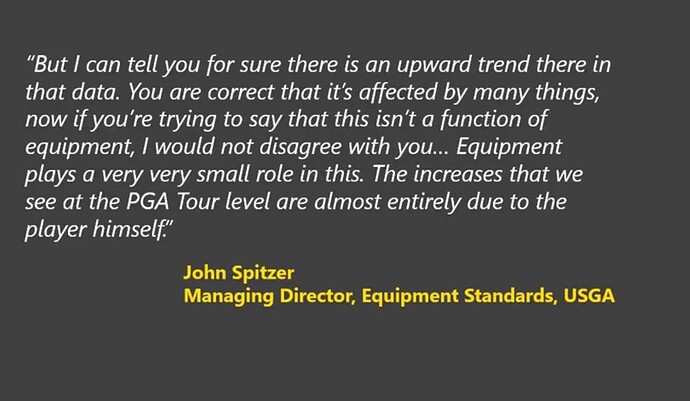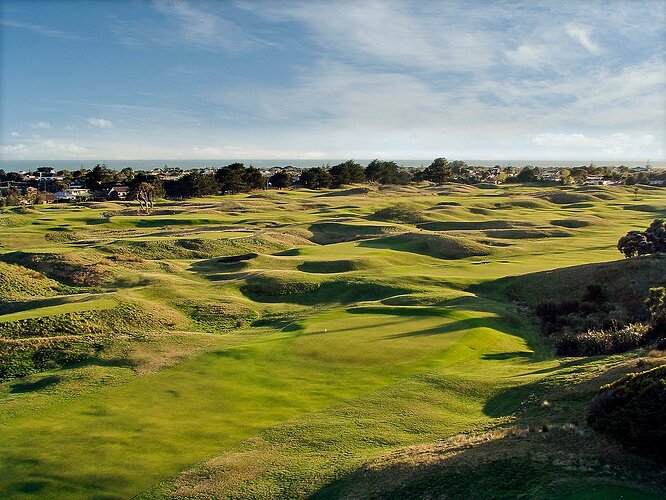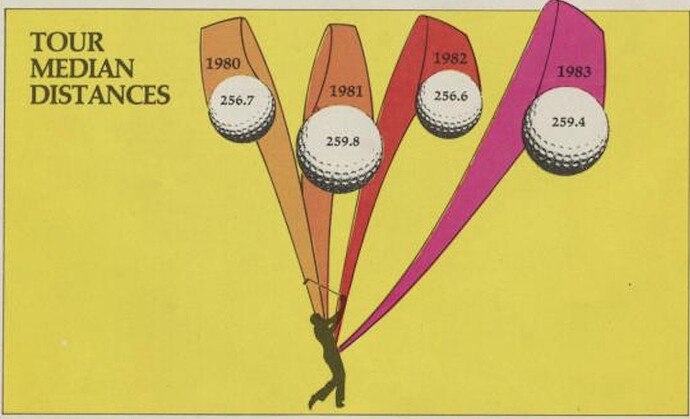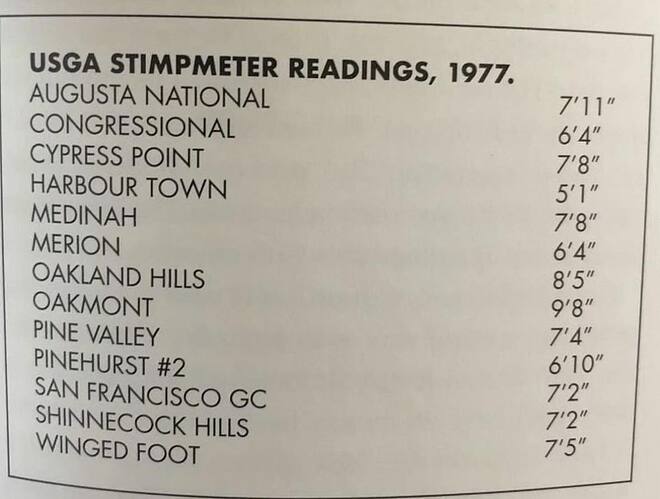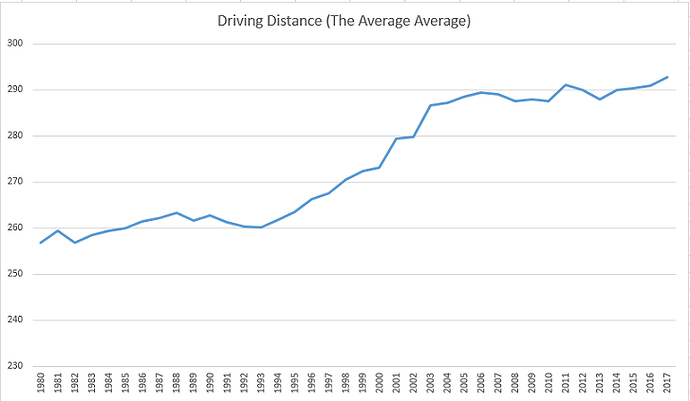St Andrews governing body has been seriously looking into the issue for six years after they announced they were conducting a joint report and three years ago their “Distance Insight Project” concluded that the ever-increasing length pros are hitting it is “detrimental to the game”.
Since then, the USGA and R&A have been consulting with the industry about the problem which they declared is beginning “to undermine the core principle that golf should require a broad range of skills to be successful”.
That is just one concern in a debate that has been raging for decades. Classic courses are in danger of becoming obsolete as players such as Rory McIlroy and Jon Rahm routinely launch drives of 350-yards plus, reducing the test, in some cases, to a drive, pitch and putt.
Longer courses are required, resulting not only in the nature of layouts being stretched sometimes beyond recognition and then there is the obvious rise in maintenance costs, with the necessity for extra water and chemicals fueling environment worries. Rounds are inevitably taking longer to compete, even in club competitions.
Did the R&A and USGA just log onto our ABS Site last week?
Gee, they could have saved a lot of money expended upon undertaking these multi year studies only to find out what we have been saying for 15 years… had they consulted us on these new realizations and findings…
I love this line:
"the problem which they declared is beginning “to undermine the core principle that golf should require a broad range of skills to be successful”.
Or:
“Classic courses are in danger of becoming obsolete as players such as Rory McIlroy and Jon Rahm routinely launch drives of 350-yards plus, reducing the test, in some cases, to a drive, pitch and putt”.
As if this hasn’t happened yet? Ok… I’m going to bed now…
It’s hard to put a golf course together. It’s absolutely incredible that so many great courses were created, designed and cared for… some of the best are nearly 100 years old now.
Try and secure some land … maybe 150 acres… in a downtown metropolitan area, or along the coastline and build a golf course. Financing, permits, inspections, soil tests, protesters…
Golfers should feel a deep appreciation for the efforts of some really great people in the past that have left these legacy courses.
The key to a great course beyond just a beautiful setting… is the layout of the holes… and those holes need to be situated in a logical flow across the land while demanding the player be tested across their entire game. Driving accuracy, distance, using all the irons into par 4 approaches… long, mid, short. Long and short par 3’s. Par 5 holes that offer an exciting heart pumping risk - reward situation to temp and tantalize the golfers bravado, fear and imagination.
Lines, angles, options, to major pin placements and with concern for predominate weather situations and the unusual as well.
A great course is something REALLY thought out in great articulation and detail.
Anyone can just map out some random holes across a property without much thought. … but that is not what a great course is all about.
The great courses are next level stuff. Someone cared, someone really went the extra mile to pursue greatness.
I am often more impressed with a great golf course architect than a great golfer.
But what we have to keep in mind is that these great courses need to be understood, respected and appreciated. They were designed with a specific parameter in mind… things like how far the ball can be driven, and how much spin can be applied to the ball to stop it, or shape it right to left or left to right. The topography and the creation of angles and in the context of creating a wide palate of shotmaking requirements and options.
Courses designed to be played across with 250 yard drives should still be played with equipment that allows that to happen… so the lines, angles, options remain intact with the original intentions. It’s simply a disgrace and disrespectful to think of it otherwise.
Too much energy, love and passion from the past generations to run them over with technology just because you can.
The equipment and the courses need to work in harmony. The preservation of skill sets from one generation to another should be one of the beautiful things about golf.
The older courses are way more interesting, they were built on land naturally suited for a great golf course. The modern courses here are built either farmland or old coal mines and have been engineered flat and lacking in natural features, dull and boring.
I hate to think that the old classics really aren’t played as intended with a frying pan and new ones are just shit.
The course I learned the game on, Paraparaumu Beach GC in New Zealand. Ranked consistently in the world top 100, par 71, 6400 yards! A true links style course that requires precision off the tee to create the best angle to attack the flag, a shot makers course. No room for expansion. It’s a shame to see great par 4’s that were a driver, 3 or 4 iron for top players, become driver, 9 iron/wedge holes. The great bunkering and shaping of the greens require great shot making when approached with long and mid irons, but are irrelevant to a high spinning wedge. This course, like all the great older courses, is designed to be played with persimmon and blades.
Nice to see Jacklin putting his hat into the ring here for the persimmon game. Great to see one of the legends of European Golf speaking up and against the grain. It’s disappointing that Palmer, Player, Nicklaus didn’t take a hard line on this early on.
Jacklin is 100% correct here. It’s NOT the ball so much as the driver itself. Irons can be anything… they should be made for accuracy concerns only and distance CONTROL.
The driver is the problem…
My goodness. These people are completely out of their fu@*in minds !
Interesting how the USGA was up in arms about the ball going two and a half yards farther in the early 80’s…
I’ve never been a supporter of homogenizing the game. I always enjoyed the challenge of playing a vast variety of conditions and learning how to play in wind, rain, fast greens, slow greens, bumpy greens, good lies, bad lies, side hill lies, uphill, downhill, fluffy sand, firm sand… etc…
I think this is one of the great qualities of the game. Learning to overcome adversity and looking forward to courses that suit your own style… while sharpening your skills on courses that don’t fit your style so well.
The “too hot” ball debate goes back 55 years! See this excerpt from the 1968 British book, Search for the Perfect Swing :
The “modern” ball of the era was considered to have a “formidable power of carry” that was ruining the game and making traditional courses obsolete. The proposed idea about a lighter ball to reduce the carry distance obviously never transpired. The ruling bodies clearly had little clout back then either.
In Arnold Palmer’s instruction book, My Game and Yours (revised ed. 1983, orig. ed. 1965), he wrote about the importance of knowing yardages for each club you play. He gave these average distances for his irons:
1 iron – 225 yards
3 iron – 185 yards
5 iron – 165 yards
7 iron – 140 yards
9 iron – 115 yards
PW – 100 yards
He stated, “Almost every pro in the business uses the pitching wedge on almost every shot from about 100 yards on and in.”
Arnie was a very strong man, yet today’s golfers would think these yardages are totally lame. Of course, a big part of the problem nowadays is the marketing gimmick of the iron number. Today’s irons are typically 2 to 2.5 clubs stronger than those from the 1960s. Examples: Arnie’s 5 iron loft would be similar in loft to a current 7 iron; his 7 iron loft would be similar to a 9 iron today.
In 2008, Golf Digest published an article entitled, “Recalling Wood Woods” (online here: https://www.golfdigest.com/story/gw20080321johnson). In the article Phil Mickelson said, “Callaway did some tests three years ago [2005] with a persimmon driver and a ball from the 1990s, comparing it to an HX Tour ball and modern driver. There was a 50-yard difference. The testing said it was 25 yards driver and 25 yards ball. So I tested it, and that turned out to be about right. I couldn’t believe how different the launch conditions were – and that was a driver I used to play with.”
What would be the test difference now, 18 years later? My guess is that the driver adds 50 yards and the ball 25 yards, for a total of 75 extra yards over the persimmon/balata era.
Average drive of a tour pro in 1983 was about 250
In 2003 the average drive was up near 300… about what it is now.
Dan Pohl was longest driver on PGA Tour in 1980 around 276 yards.
In 2003 top driver was around 320
So about 20% either way… average or top distance pros.
However, I certainly don’t hit the ball 20% farther off my irons. Not much difference at all with my irons. When i was on tour… 150 yards was a hard 8 iron or a smooth 7 iron.
About the same now. I don’t hit an 8 iron 180 yards… which would be 20% farther from 150. I could be 5 yards as most but not more. I don’t hit the modern ball much farther off a persimmon driver than I did with a nice new fresh balata.
The modern driver I am convinced is the culprit for the better players. Adding 3 inches, huge head that a player can swing so much harder at… and it’s lighter for more speed as well as the springboard effect off the clubface.
There is another thing to consider also. I believe the modern driver takes a different technique than what you would use for a classic blade iron. Getting into 115 to 120 mph swing speeds is not going to be a pivot driven swing. Those that attempt that… are probably suffering injury at some point. So many young players a getting surgeries on their knees, hips, back.
I feel it’s a very bad direction the game is going.
True.
I bought 6 dozen of NOS Titleist DT90 wound balls 3 years ago and am almost through my supply now, so sometimes play modern balls as well (Bridgestone Tour B RXS). I don’t see any real difference in distance between the 30 year old Titleist’s and the new Bridgestones. Not with my irons, and not with my persimmons. But then again, these new balls have not been designed for use with persimmons. They have been optimized for the modern drivers (and vice versa), so you will most likely see a difference in distance between old and new balls when hitting a modern driver.
That’s why I am not overly enthousiastic about the proposal to change the ball, as 1) it will 100% certainty not take into account how that ball will react to an assault with a 200cc persimmon block (and most likely will result in loss of distance with persimmon, not just compared to today, but also compared to 30-40 years ago), and 2) ball manufacturers get more room to optimize the ball for slower swingspeeds, so you may be limited in distance when hitting a driver at 127mph, but that reduced distance ball might fly longer with your irons.
I think they should address forgiveness in golfclubs. Most of you will have heard of DECADE by Scott Fawcett, which makes use of the fact that you may miss your shots 30 yards left of target or 30 yards right of target, but also, that you may only miss long or short in a much smaller distance (so you can pic a target within a 20x60 yard rectangle on each hole). Where 30 years ago gear effect might have helped you missing just 25 yards left/right of target on a bad drive, but that drive could end up 50-60 yards shorter than a well struck drive. Hence the area your drive might end up in becomes 60x50 yards. Guess in which of those too you can find more trouble (and where a good vs a bad drive might lead to one club extra on your approach, the same bad drive 30 years ago could turn an 8 iron approach into a 4 or 5 iron).
Thinking of “Stick and Ball” games…
I am sure golf is by far the stick and ball game taking up the most real estate.
It makes no sense… especially in today’s age to force the golfer’s playing field to continue to expand based upon technological changes in the clubs and ball.
Baseball, Cricket, Tennis, Billiards, Hockey, Polo, just to name a few… nothing is close to the size of a golf course playing field.
Costs rise… maintenance, fertilizer, environmental factors, permitting… so many factors just adding up that don’t make sense to “grow the size of the playing field”.
I downloaded the official PGA stats for average driving distances into an Excel spreadsheet and created three graphs: i) lowest average PGA Tour driving distance, ii) average PGA Tour driving distance, iii) highest average (leader) PGA Tour driving distance. The best-fit trendline for all three graphs is a fairly uniform (linear) increase over the decades since the persimmon/balata era.
The trendline slopes for the first two graphs both show a distance increase of 1.09 yards per year, which results in a distance increase of 47 yards over 43 years.
The trendline slope for the third graph is slightly greater at 1.24 yards per year, which results in a distance increase of 53 yards over 43 years.
Bottom line is a round number driving distance increase of approx. 50 yards for PGA Tour players since 1980.
The 2008 Golf Digest article (https://www.golfdigest.com/story/gw20080321johnson) was revisited in relation to the PGA data. The 2005 Callaway tests (which Phil Mickelson also tested for himself) don’t jibe with these PGA stats. Based on the PGA trendlines, the overall increase in 2005 would have been approx. 30 yards on tour, yet the Callaway results (according to Phil) measured a 50 yard gain versus persimmon/balata technology. How did they manage to get 20 more yards with their testing? Different testing protocol and perhaps more advantageous variables (wind direction, firmness/speed of fairways for added roll, etc.)?
What I calculated a while back shows:
4 yard change from 1980 to 1993
26 yard change from 1993 to 2003
6 yard change from 2003 to 2017
So, a linear trend line does not tell the story very well, IMO. The majority of the change came in about a one decade period. Outside of that, driving distances moved only a little, on average, season to season. 2017 was the last year I did it - haven’t run the code since.
